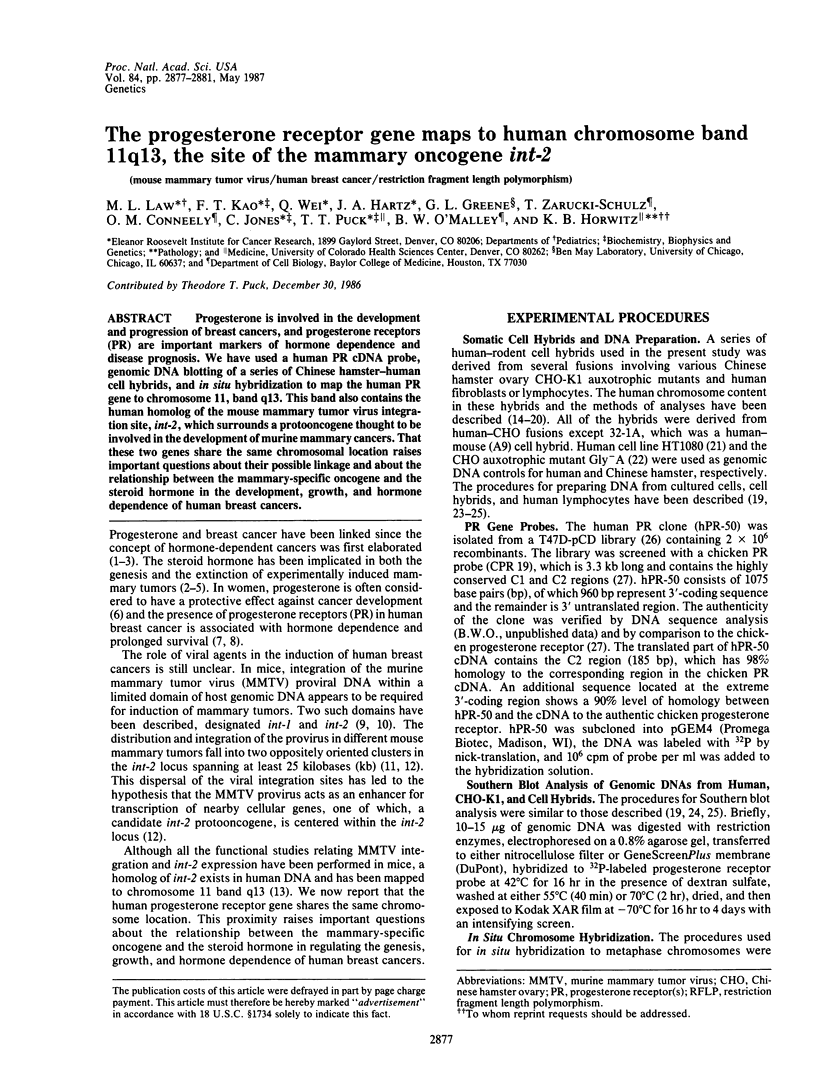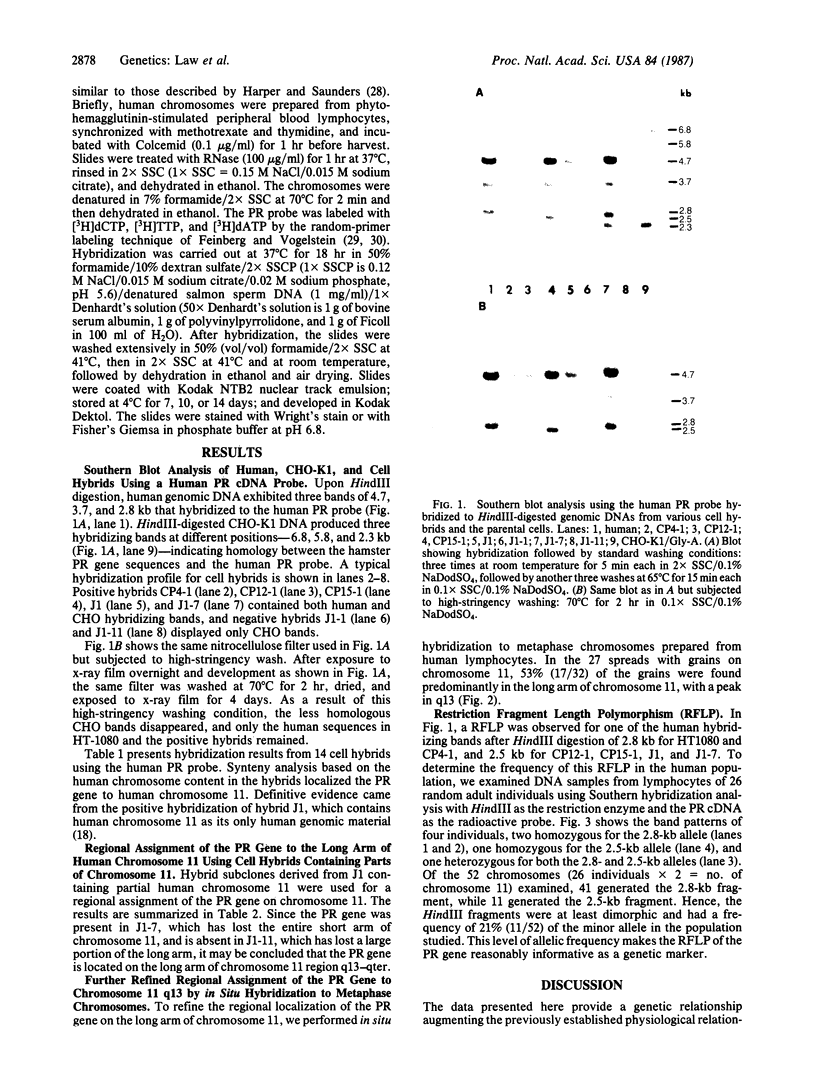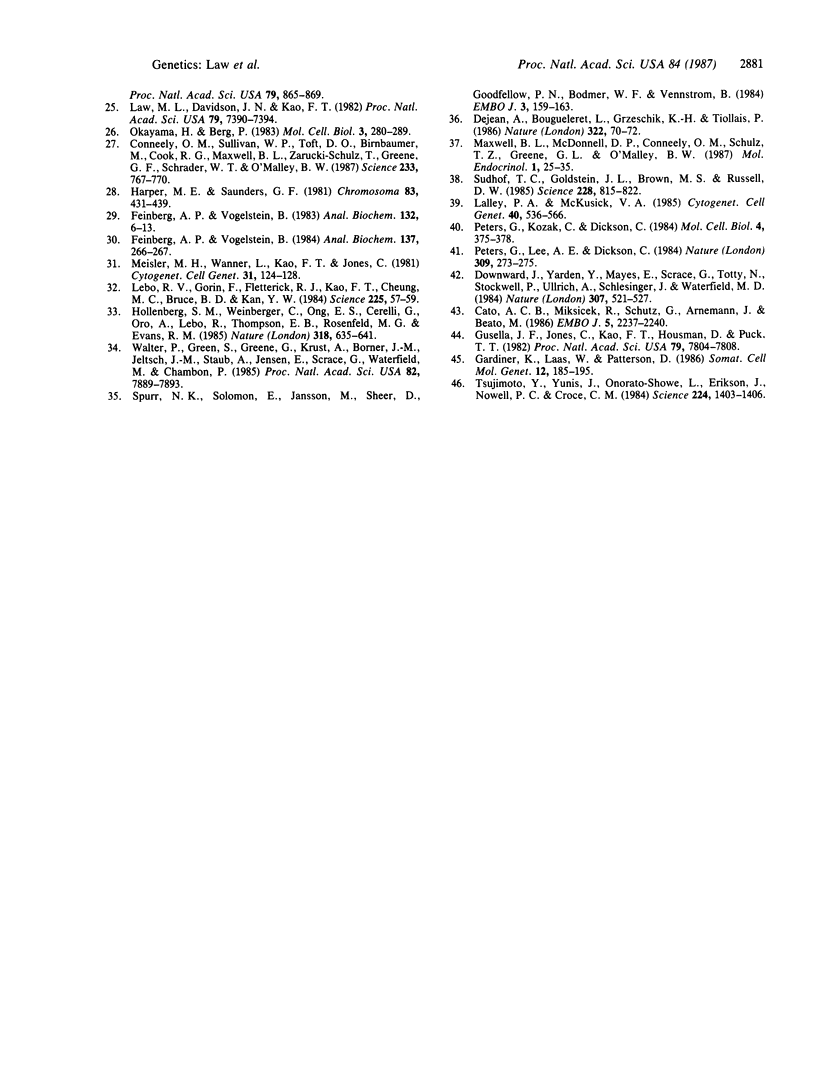Abstract
Progesterone is involved in the development and progression of breast cancers, and progesterone receptors (PR) are important markers of hormone dependence and disease prognosis. We have used a human PR cDNA probe, genomic DNA blotting of a series of Chinese hamster-human cell hybrids, and in situ hybridization to map the human PR gene to chromosome 11, band q13. This band also contains the human homolog of the mouse mammary tumor virus integration site, int-2, which surrounds a protooncogene thought to be involved in the development of murine mammary cancers. That these two genes share the same chromosomal location raises important questions about their possible linkage and about the relationship between the mammary-specific oncogene and the steroid hormone in the development, growth, and hormone dependence of human breast cancers.
Full text
PDF




Images in this article
Selected References
These references are in PubMed. This may not be the complete list of references from this article.
- Casey G., Smith R., McGillivray D., Peters G., Dickson C. Characterization and chromosome assignment of the human homolog of int-2, a potential proto-oncogene. Mol Cell Biol. 1986 Feb;6(2):502–510. doi: 10.1128/mcb.6.2.502. [DOI] [PMC free article] [PubMed] [Google Scholar]
- Cato A. C., Miksicek R., Schütz G., Arnemann J., Beato M. The hormone regulatory element of mouse mammary tumour virus mediates progesterone induction. EMBO J. 1986 Sep;5(9):2237–2240. doi: 10.1002/j.1460-2075.1986.tb04490.x. [DOI] [PMC free article] [PubMed] [Google Scholar]
- Cheung P., Kao F. T., Law M. L., Jones C., Puck T. T., Chan L. Localization of the structural gene for human apolipoprotein A-I on the long arm of human chromosome 11. Proc Natl Acad Sci U S A. 1984 Jan;81(2):508–511. doi: 10.1073/pnas.81.2.508. [DOI] [PMC free article] [PubMed] [Google Scholar]
- Clark G. M., McGuire W. L., Hubay C. A., Pearson O. H., Marshall J. S. Progesterone receptors as a prognostic factor in Stage II breast cancer. N Engl J Med. 1983 Dec 1;309(22):1343–1347. doi: 10.1056/nejm198312013092240. [DOI] [PubMed] [Google Scholar]
- Conneely O. M., Sullivan W. P., Toft D. O., Birnbaumer M., Cook R. G., Maxwell B. L., Zarucki-Schulz T., Greene G. L., Schrader W. T., O'Malley B. W. Molecular cloning of the chicken progesterone receptor. Science. 1986 Aug 15;233(4765):767–770. doi: 10.1126/science.2426779. [DOI] [PubMed] [Google Scholar]
- Croce C. M. Loss of mouse chromosomes in somatic cell hybrids between HT-1080 human fibrosarcoma cells and mouse peritioneal macrophages. Proc Natl Acad Sci U S A. 1976 Sep;73(9):3248–3252. doi: 10.1073/pnas.73.9.3248. [DOI] [PMC free article] [PubMed] [Google Scholar]
- Dejean A., Bougueleret L., Grzeschik K. H., Tiollais P. Hepatitis B virus DNA integration in a sequence homologous to v-erb-A and steroid receptor genes in a hepatocellular carcinoma. Nature. 1986 Jul 3;322(6074):70–72. doi: 10.1038/322070a0. [DOI] [PubMed] [Google Scholar]
- Dickson C., Smith R., Brookes S., Peters G. Tumorigenesis by mouse mammary tumor virus: proviral activation of a cellular gene in the common integration region int-2. Cell. 1984 Jun;37(2):529–536. doi: 10.1016/0092-8674(84)90383-0. [DOI] [PubMed] [Google Scholar]
- Downward J., Yarden Y., Mayes E., Scrace G., Totty N., Stockwell P., Ullrich A., Schlessinger J., Waterfield M. D. Close similarity of epidermal growth factor receptor and v-erb-B oncogene protein sequences. Nature. 1984 Feb 9;307(5951):521–527. doi: 10.1038/307521a0. [DOI] [PubMed] [Google Scholar]
- Feinberg A. P., Vogelstein B. "A technique for radiolabeling DNA restriction endonuclease fragments to high specific activity". Addendum. Anal Biochem. 1984 Feb;137(1):266–267. doi: 10.1016/0003-2697(84)90381-6. [DOI] [PubMed] [Google Scholar]
- Feinberg A. P., Vogelstein B. A technique for radiolabeling DNA restriction endonuclease fragments to high specific activity. Anal Biochem. 1983 Jul 1;132(1):6–13. doi: 10.1016/0003-2697(83)90418-9. [DOI] [PubMed] [Google Scholar]
- Gardiner K., Laas W., Patterson D. Fractionation of large mammalian DNA restriction fragments using vertical pulsed-field gradient gel electrophoresis. Somat Cell Mol Genet. 1986 Mar;12(2):185–195. doi: 10.1007/BF01560665. [DOI] [PubMed] [Google Scholar]
- Gusella J. F., Jones C., Kao F. T., Housman D., Puck T. T. Genetic fine-structure mapping in human chromosome 11 by use of repetitive DNA sequences. Proc Natl Acad Sci U S A. 1982 Dec;79(24):7804–7808. doi: 10.1073/pnas.79.24.7804. [DOI] [PMC free article] [PubMed] [Google Scholar]
- Gusella J., Varsanyi-Breiner A., Kao F. T., Jones C., Puck T. T., Keys C., Orkin S., Housman D. Precise localization of human beta-globin gene complex on chromosome 11. Proc Natl Acad Sci U S A. 1979 Oct;76(10):5239–5242. doi: 10.1073/pnas.76.10.5239. [DOI] [PMC free article] [PubMed] [Google Scholar]
- HUGGINS C., MOON R. C., MORII S. Extinction of experimental mammary cancer. I. Estradiol-17beta and progesterone. Proc Natl Acad Sci U S A. 1962 Mar 15;48:379–386. doi: 10.1073/pnas.48.3.379. [DOI] [PMC free article] [PubMed] [Google Scholar]
- HUGGINS C., YANG N. C. Induction and extinction of mammary cancer. A striking effect of hydrocarbons permits analysis of mechanisms of causes and cure of breast cancer. Science. 1962 Jul 27;137(3526):257–262. doi: 10.1126/science.137.3526.257. [DOI] [PubMed] [Google Scholar]
- Harper M. E., Saunders G. F. Localization of single copy DNA sequences of G-banded human chromosomes by in situ hybridization. Chromosoma. 1981;83(3):431–439. doi: 10.1007/BF00327364. [DOI] [PubMed] [Google Scholar]
- Hollenberg S. M., Weinberger C., Ong E. S., Cerelli G., Oro A., Lebo R., Thompson E. B., Rosenfeld M. G., Evans R. M. Primary structure and expression of a functional human glucocorticoid receptor cDNA. Nature. 1985 Dec 19;318(6047):635–641. doi: 10.1038/318635a0. [DOI] [PMC free article] [PubMed] [Google Scholar]
- Horwitz K. B., McGuire W. L. Predicting response to endocrine therapy in human breast cancer: a hypothesis. Science. 1975 Aug 29;189(4204):726–727. doi: 10.1126/science.168640. [DOI] [PubMed] [Google Scholar]
- Huggins C., Scott W. W. Bilateral Adrenalectomy in Prostatic Cancer: Clinical Features and Urinary Excretion of 17-Ketosteroids and Estrogen. Ann Surg. 1945 Dec;122(6):1031–1041. [PMC free article] [PubMed] [Google Scholar]
- Inui K., Kao F. T., Fujibayashi S., Jones C., Morse H. G., Law M. L., Wenger D. A. The gene coding for a sphingolipid activator protein, SAP-1, is on human chromosome 10. Hum Genet. 1985;69(3):197–200. doi: 10.1007/BF00293023. [DOI] [PubMed] [Google Scholar]
- Jabara A. G., Harcourt A. G. The effects of progesterone and ovariectomy on mammary tumours induced by 7,1 2-dimethylbenz(a)anthracene in Sprague-Dawley rats. Pathology. 1970 Apr;2(2):115–123. doi: 10.3109/00313027009077333. [DOI] [PubMed] [Google Scholar]
- Jones C., Kao F. T. Regional mapping of the gene for human lysosomal acid phosphatase (ACP2) using a hybrid clone panel containing segments of human chromosome 11. Hum Genet. 1978 Nov 24;45(1):1–10. doi: 10.1007/BF00277567. [DOI] [PubMed] [Google Scholar]
- Kao F. T., Jones C., Puck T. T. Genetics of somatic mammalian cells: genetic, immunologic, and biochemical analysis with Chinese hamster cell hybrids containing selected human chromosomes. Proc Natl Acad Sci U S A. 1976 Jan;73(1):193–197. doi: 10.1073/pnas.73.1.193. [DOI] [PMC free article] [PubMed] [Google Scholar]
- Kao F. T., Morse H. G., Law M. L., Lidsky A., Chandra T., Woo S. L. Genetic mapping of the structural gene for antithrombin III to human chromosome 1. Hum Genet. 1984;67(1):34–36. doi: 10.1007/BF00270555. [DOI] [PubMed] [Google Scholar]
- Kaufman D. W., Shapiro S., Slone D., Rosenberg L., Miettinen O. S., Stolley P. D., Knapp R. C., Leavitt T., Jr, Watring W. G., Rosenshein N. B. Decreased risk of endometrial cancer among oral-contraceptive users. N Engl J Med. 1980 Oct 30;303(18):1045–1047. doi: 10.1056/NEJM198010303031807. [DOI] [PubMed] [Google Scholar]
- Lalley P. A., McKusick V. A. Report of the Committee on Comparative Mapping. Cytogenet Cell Genet. 1985;40(1-4):536–566. doi: 10.1159/000132187. [DOI] [PubMed] [Google Scholar]
- Law M. L., Cai G. Y., Lin F. K., Wei Q., Huang S. Z., Hartz J. H., Morse H., Lin C. H., Jones C., Kao F. T. Chromosomal assignment of the human erythropoietin gene and its DNA polymorphism. Proc Natl Acad Sci U S A. 1986 Sep;83(18):6920–6924. doi: 10.1073/pnas.83.18.6920. [DOI] [PMC free article] [PubMed] [Google Scholar]
- Law M. L., Davidson J. N., Kao F. T. Isolation of a human repetitive sequence and its application to regional chromosome mapping. Proc Natl Acad Sci U S A. 1982 Dec;79(23):7390–7394. doi: 10.1073/pnas.79.23.7390. [DOI] [PMC free article] [PubMed] [Google Scholar]
- Law M. L., Kao F. T. Induced segregation of human syntenic genes by 5-bromodeozyuridine + near-visible light. Somatic Cell Genet. 1978 Jul;4(4):465–476. doi: 10.1007/BF01538867. [DOI] [PubMed] [Google Scholar]
- Lebo R. V., Gorin F., Fletterick R. J., Kao F. T., Cheung M. C., Bruce B. D., Kan Y. W. High-resolution chromosome sorting and DNA spot-blot analysis assign McArdle's syndrome to chromosome 11. Science. 1984 Jul 6;225(4657):57–59. doi: 10.1126/science.6587566. [DOI] [PubMed] [Google Scholar]
- Maxwell B. L., McDonnell D. P., Conneely O. M., Schulz T. Z., Greene G. L., O'Malley B. W. Structural organization and regulation of the chicken estrogen receptor. Mol Endocrinol. 1987 Jan;1(1):25–35. doi: 10.1210/mend-1-1-25. [DOI] [PubMed] [Google Scholar]
- Moore R., Casey G., Brookes S., Dixon M., Peters G., Dickson C. Sequence, topography and protein coding potential of mouse int-2: a putative oncogene activated by mouse mammary tumour virus. EMBO J. 1986 May;5(5):919–924. doi: 10.1002/j.1460-2075.1986.tb04304.x. [DOI] [PMC free article] [PubMed] [Google Scholar]
- Nusse R., Varmus H. E. Many tumors induced by the mouse mammary tumor virus contain a provirus integrated in the same region of the host genome. Cell. 1982 Nov;31(1):99–109. doi: 10.1016/0092-8674(82)90409-3. [DOI] [PubMed] [Google Scholar]
- Okayama H., Berg P. A cDNA cloning vector that permits expression of cDNA inserts in mammalian cells. Mol Cell Biol. 1983 Feb;3(2):280–289. doi: 10.1128/mcb.3.2.280. [DOI] [PMC free article] [PubMed] [Google Scholar]
- Peters G., Brookes S., Smith R., Dickson C. Tumorigenesis by mouse mammary tumor virus: evidence for a common region for provirus integration in mammary tumors. Cell. 1983 Jun;33(2):369–377. doi: 10.1016/0092-8674(83)90418-x. [DOI] [PubMed] [Google Scholar]
- Peters G., Kozak C., Dickson C. Mouse mammary tumor virus integration regions int-1 and int-2 map on different mouse chromosomes. Mol Cell Biol. 1984 Feb;4(2):375–378. doi: 10.1128/mcb.4.2.375. [DOI] [PMC free article] [PubMed] [Google Scholar]
- Peters G., Lee A. E., Dickson C. Activation of cellular gene by mouse mammary tumour virus may occur early in mammary tumour development. Nature. 1984 May 17;309(5965):273–275. doi: 10.1038/309273a0. [DOI] [PubMed] [Google Scholar]
- Spurr N. K., Solomon E., Jansson M., Sheer D., Goodfellow P. N., Bodmer W. F., Vennstrom B. Chromosomal localisation of the human homologues to the oncogenes erbA and B. EMBO J. 1984 Jan;3(1):159–163. doi: 10.1002/j.1460-2075.1984.tb01777.x. [DOI] [PMC free article] [PubMed] [Google Scholar]
- Südhof T. C., Goldstein J. L., Brown M. S., Russell D. W. The LDL receptor gene: a mosaic of exons shared with different proteins. Science. 1985 May 17;228(4701):815–822. doi: 10.1126/science.2988123. [DOI] [PMC free article] [PubMed] [Google Scholar]
- Tsujimoto Y., Yunis J., Onorato-Showe L., Erikson J., Nowell P. C., Croce C. M. Molecular cloning of the chromosomal breakpoint of B-cell lymphomas and leukemias with the t(11;14) chromosome translocation. Science. 1984 Jun 29;224(4656):1403–1406. doi: 10.1126/science.6610211. [DOI] [PubMed] [Google Scholar]
- Walter P., Green S., Greene G., Krust A., Bornert J. M., Jeltsch J. M., Staub A., Jensen E., Scrace G., Waterfield M. Cloning of the human estrogen receptor cDNA. Proc Natl Acad Sci U S A. 1985 Dec;82(23):7889–7893. doi: 10.1073/pnas.82.23.7889. [DOI] [PMC free article] [PubMed] [Google Scholar]
- Welsch C. W., Clemens J. A., Meites J. Effects of multiple pituitary homografts or progesterone on 7,12-dimethylbenz[a]anthracene-induced mammary tumors in rats. J Natl Cancer Inst. 1968 Aug;41(2):465–471. [PubMed] [Google Scholar]





